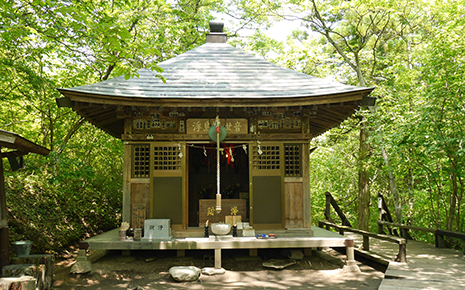Fukiware Falls

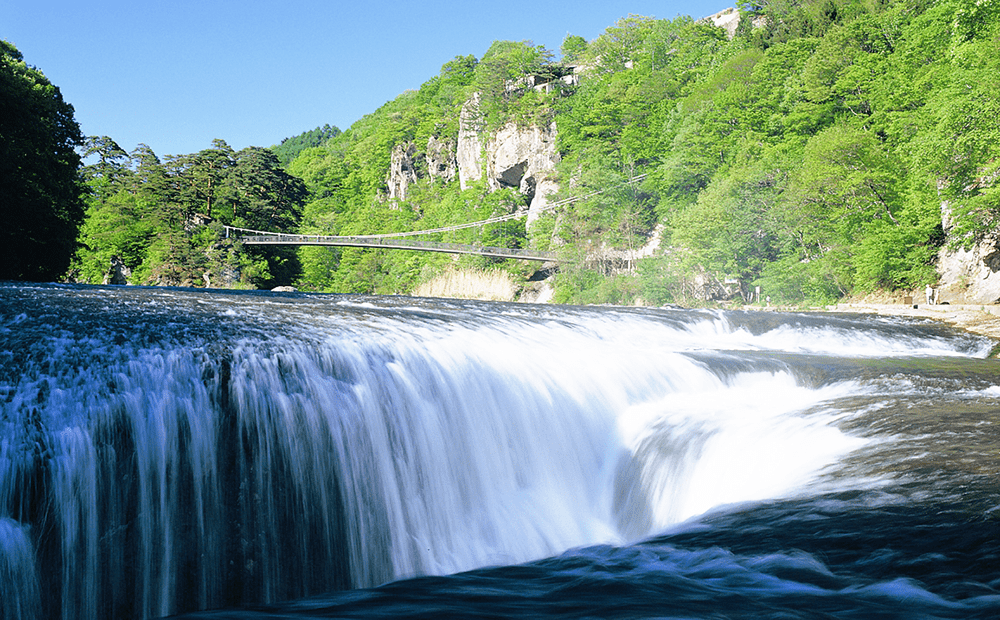
About Fukiware Falls
Fukiware Falls are known as the oriental Niagara Falls.
Experience this dynamic waterfall surrounded by beautiful scenery. On a hot summer day, the fine mist from the waterfall cools you down. This famous waterfall changes its appearance every seasons; spring and autumn colors attracts many visitors. Explore the majestic nature in Tone area by walking around the trail.
After the excitement of the waterfall, visit Oigami-Onsen hot springs. Comfort your mind and body with hot springs rich in minerals.
Fukiware Ravine and Fukiware Falls
Katashina River forms a ravine between the upper stream at the confluence point with Hiragawa River and downstream at the confluence point with Kurihara River. This is called Fukiware Ravine. The ravine was formed by scraping tuff rocks and welded-tuff rocks. On the right bank, Shoji-iwa rock rises steeply.
The riverbed is mainly flat tuff rocks, and especially wide the flat riverbed is called Senjojiki. There are a number of potholes on the riverbed spreading approximately 1.5km between Fukiware Falls and Nigura Rock.
The plane shape of the potholes is mostly circular, and they are all a long shape at right angle against river current. The biggest size is around 6 to7 meters to the major axis, but mostly 2 to 3 meters.
Several faults traverse the tuff rock in the riverbed, and siliceous material and calcareous mineral solution penetrated into the faults and settled there. About 1 meter to the right and left of the faults hardened and protruded by not being eroded. These unique beautiful rocks are called Byobu-iwa (folding screen rock) and Shishi-iwa (lion rock). Fukiware Falls were named after the way the waterfall was blowing and smashing the rock: the way the waterfall is falling the side of U-shaped valley formed along the gap of the faults.
The one hour walking trail around the ravine was completed in 1991. There are three lookout decks from where the view of the ravine can be enjoyed from different angles.
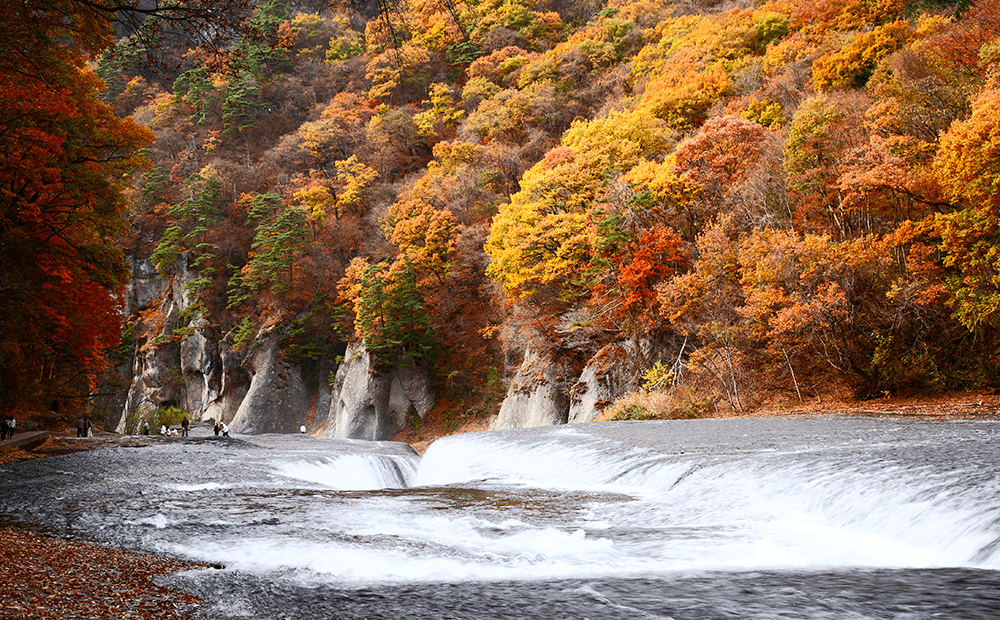
Fukiware Falls
With 7 meters height and 30 meters wide, this wildly splashing waterfall is known as the oriental Niagara Falls. The soft part of the bedrock on the riverbed of the waterfall was eroded causing many cracks. The biggest crack became the waterfall, and it looks like huge rock was blown and smashed. That is why it was named Fukiware Falls.
Many tourists visit this waterfall due to its academic value because it was formed by water erosion. In the spring, in April to May, the dynamic waterfall energetically splashes as snow melts into the water. In fall, the beautiful ravine along with vivid autumn leaves surround the waterfall. You will enjoy different appearances depending on the season.
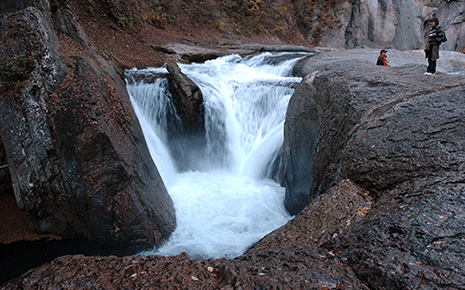
Masutobi Fall
This waterfall is located at the downstream of Fukiware ravine. A long time ago, trout was swimming towards upstream in Katashina River, side stream of Tone River; however, trout could not go upstream because of the difference in level when they reached this waterfall. It was named after the way trout were jumping and trying to go beyond the waterfall. It is 15 meters height and 6 meters wide.
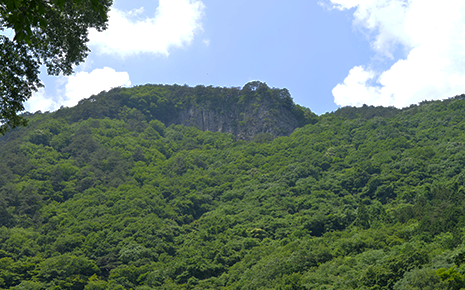
Byobu-iwa Rock
When you look up, you will see enormous rock rising up. It is called Byobu-iwa as it resembles a folding screen. This rock was formed when a pyroclastic flow ran and hardened 8.5 million years ago.
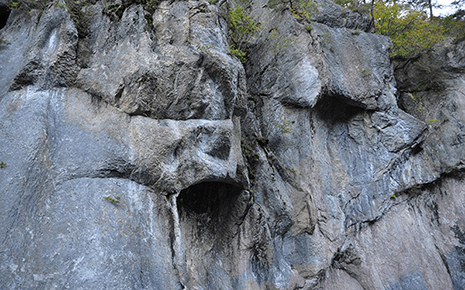
Hannya-iwa Rock
Hannya-iwa is a rock wall rising up at right bank of Fukiware Falls downstream, and named after Hannya (Japanese traditional female demon).
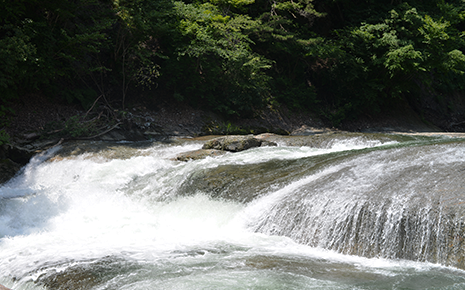
Shishi-iwa Rock
This rock is located at the center of downstream Fukiware Falls and named after being resembled lion.
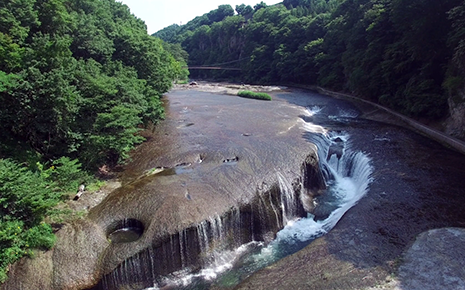
Potholes
Potholes were formed when stones on the riverbed dug down the rock by spinning with power of water. Formed nifty by water and gravels, the potholes in various sizes are viewed at the downstream of Fukiware Falls.
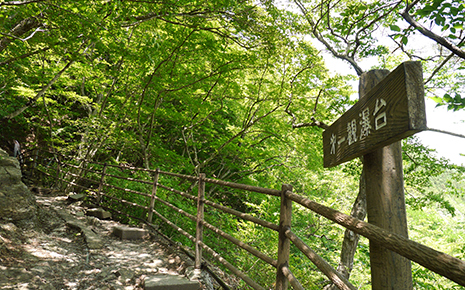
Trails
After viewing Fukiware Falls, let’s stroll over Ukijima Kannon-do Hall (a temple dedicated to Goddess of mercy) by crossing over Ukijima Bridge. After a one hour easy walk along the trail, you will reach a lookout deck with a great view of the waterfall. Have a great time by forest bathing and listening to the sound of the waterfall.
Legend of Fukiware Falls
Fukiware Falls’ basin has been believed to lead to Ryugu, the underwater palace of the Dragon, since very long time ago.
Once upon a time, the villagers used to borrow plates and bowls from Ryugu when they held ceremonies. After throwing a request letter into the waterfall when needed, the letter was caught up in the swirl and was swallowed deep into Ryugu. On the next day, requested numbers of the plates and bowls were placed on the rock by the side. After placing them back on the same rock along with thank you letter within three days, they disappeared before noticing and were returned to Ryugu.
However, one time, the villagers accidentally forgot to return one of the sets. Ryugu noticed one set was missing. After that, the villagers could never borrow them any more even though they begged politely.
This set of plate and bowl is called Ryugu’s Bowl and stored with great care.
※ Ryugu’s Bowl is not permitted to be viewed since it is kept by a private citizen.
History of Ukishima-Kannon and Kannon-Do Hall
It has been told for a long time that Ukishima-nyoirin-kannon (goddess of mercy) was a work of a master craftsman, Jingoro Hidari. He joined the construction of Nikko Toshogu shrine as a master sculpture carpenter during Kanei Era. It has been told that he completed thousands of sculptures including the famous ‘Nemuri-neko (sleeping cat)’. It is unclear when Jingoro Hidari visited the Numata area. But he visited Nikko several times after the completion of Toshogu in 1636. On the way home of his several visits, he passed through the Konsei Pass and went through Numata staying a night at Okkai-yado inn. It seemed that he sculptured the Kannon statue at that time. It has been said that this was a one night work of Jingoro Hidari.
To support this, a valuable wooden fish carved with Ebisu diety and ink brush painting of Daikoku diety were found at Katashina Village, the neighbouring village. There was a signature of Jingoro Hidari dated Shoho year 2 (1645) on the ink brush painting. This is currently exhibited at Chigira Museum in Higashiogawa.
This Kannon statue is currently applied with gold leaf although it was originally a white wood carving. A person brought this Kannon statue to traditional lacquer painter called Ishimaru in Maebashi in 1893 and requested to gild it with gold leaf. But the person never picked it up and it was kept at Ishimaru Family until 1952. Although Ishimaru Family’s house was burned down due to an air raid in Maebashi on Aug. 5, 1945, the family saved the Kannon statue from being destroyed by fire by carrying out along with other valuables. When the Kannon statue was returned here in March 1945 and welcomed by many people, the statue supposed to be white wooded was already applied with gold leaf. It had been temporarily enshrined at Kaizoji temple in Okkai after that. On the opening day of Ukishima Bridge, April 26, 1990, it was moved here and enshrined after 97 years’ absence.
According to the record, Kannon-do hall was founded by Kannon-fudobishamon-daishi (great monk priest) in 795, early Heian era. After that, the principal image was revived in 1469, and moreover, the enshrinement hall was re-built in 1534 and existed until recently.
However, it became severely decrepit and was newly built in May 1984 retaining its original appearance.
